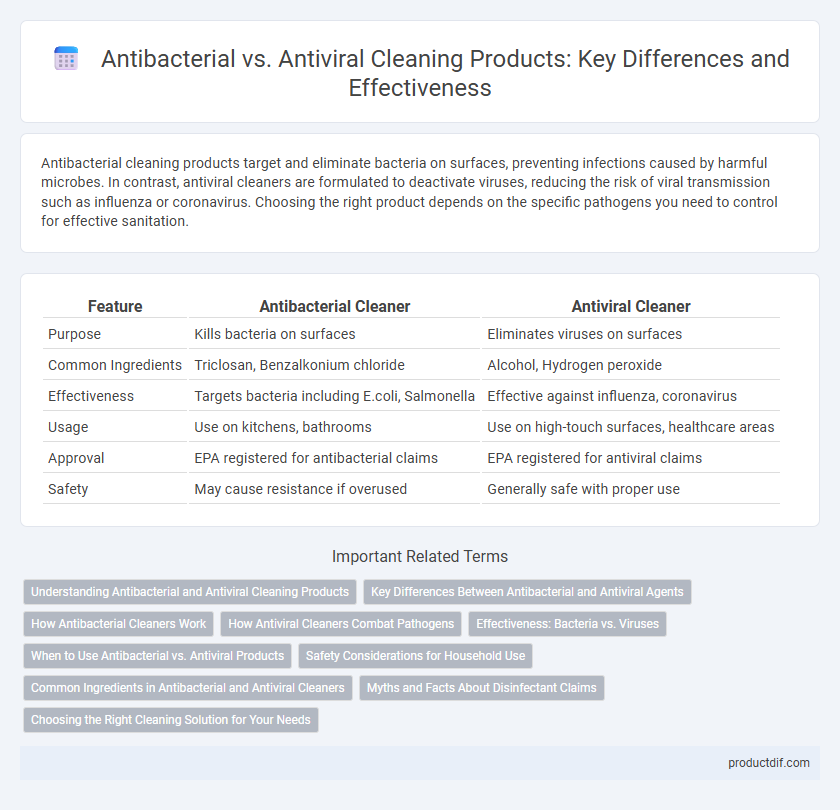Antibacterial cleaning products target and eliminate bacteria on surfaces, preventing infections caused by harmful microbes. In contrast, antiviral cleaners are formulated to deactivate viruses, reducing the risk of viral transmission such as influenza or coronavirus. Choosing the right product depends on the specific pathogens you need to control for effective sanitation.
Table of Comparison
| Feature | Antibacterial Cleaner | Antiviral Cleaner |
|---|---|---|
| Purpose | Kills bacteria on surfaces | Eliminates viruses on surfaces |
| Common Ingredients | Triclosan, Benzalkonium chloride | Alcohol, Hydrogen peroxide |
| Effectiveness | Targets bacteria including E.coli, Salmonella | Effective against influenza, coronavirus |
| Usage | Use on kitchens, bathrooms | Use on high-touch surfaces, healthcare areas |
| Approval | EPA registered for antibacterial claims | EPA registered for antiviral claims |
| Safety | May cause resistance if overused | Generally safe with proper use |
Understanding Antibacterial and Antiviral Cleaning Products
Antibacterial cleaning products target and eliminate bacteria by disrupting their cell walls or metabolic processes, ensuring surfaces are free from harmful bacterial contamination. Antiviral cleaning products are formulated to inactivate viruses by breaking down their lipid envelopes or protein coats, effectively reducing viral transmission on surfaces. Understanding the distinct mechanisms and applications of antibacterial and antiviral cleaners is crucial for selecting the appropriate product to maintain a hygienic environment.
Key Differences Between Antibacterial and Antiviral Agents
Antibacterial agents target and eliminate bacteria by disrupting their cell walls or inhibiting essential bacterial functions, while antiviral agents specifically inhibit the replication of viruses within host cells. Antibacterial products are effective against bacterial infections such as Staphylococcus aureus and E. coli, whereas antiviral agents combat viruses like influenza and coronavirus by blocking viral entry or replication. Understanding these key differences ensures appropriate use of cleaning products to effectively reduce specific microbial contamination and enhance infection control.
How Antibacterial Cleaners Work
Antibacterial cleaners target and eliminate bacteria by disrupting their cell walls or interfering with cellular functions, effectively reducing bacterial presence on surfaces. These products often contain agents like triclosan, alcohol, or quaternary ammonium compounds, which compromise bacterial membranes and inhibit reproduction. Unlike antiviral cleaners that neutralize viruses by destroying their protein coats or genetic material, antibacterial cleaners specifically focus on bacterial microorganisms to maintain hygienic environments.
How Antiviral Cleaners Combat Pathogens
Antiviral cleaners combat pathogens by disrupting the lipid envelope or protein coat of viruses, effectively inactivating their ability to infect host cells. These products often contain ingredients such as quaternary ammonium compounds, hydrogen peroxide, or ethanol, which penetrate viral structures and break down their vital components. Unlike antibacterial cleaners that target bacteria-specific features like cell walls, antiviral cleaners specifically neutralize viruses, making them essential for controlling viral outbreaks and preventing disease transmission.
Effectiveness: Bacteria vs. Viruses
Antibacterial cleaning products target and eliminate bacteria by disrupting cell walls or inhibiting essential enzymes, proving effective against common pathogens like E. coli and Staphylococcus aureus. Antiviral cleaners, on the other hand, neutralize viruses by breaking down viral envelopes or denaturing proteins, essential for combating influenza, coronavirus, and other viral agents. Choosing the right product depends on the specific microorganisms present, highlighting the importance of using antivirals for virus-laden surfaces and antibacterials for bacterial contamination.
When to Use Antibacterial vs. Antiviral Products
Antibacterial cleaning products are most effective in targeting and eliminating bacteria on surfaces, making them ideal for environments prone to bacterial contamination like kitchens and bathrooms. Antiviral products should be used when there is a concern about viral exposure, such as during flu season or outbreaks of viral illnesses like COVID-19, to inactivate viruses on high-touch surfaces. Choosing the appropriate product depends on the specific pathogens present and the desired level of protection in a particular setting.
Safety Considerations for Household Use
Antibacterial cleaning products target bacteria and may contribute to resistance if overused, requiring careful application to prevent skin irritation or respiratory issues in household environments. Antiviral cleaners specifically neutralize viruses and often contain ingredients like ethanol or hydrogen peroxide, which must be used with proper ventilation and kept away from children to ensure safety. Selecting products labeled safe for household use and following manufacturer instructions minimizes health risks while effectively maintaining hygiene.
Common Ingredients in Antibacterial and Antiviral Cleaners
Common ingredients in antibacterial cleaners include triclosan, benzalkonium chloride, and alcohol, which target bacteria by disrupting their cell walls or metabolic processes. Antiviral cleaners often contain hydrogen peroxide, ethanol, and sodium hypochlorite, effective in inactivating viruses by denaturing proteins and damaging viral envelopes. Both types may share surfactants and fragrances, but their primary active agents differ to specifically combat bacteria or viruses.
Myths and Facts About Disinfectant Claims
Many disinfectant products claim both antibacterial and antiviral properties, but these terms target different types of pathogens: bacteria and viruses, respectively. Some products labeled as antibacterial may not effectively neutralize viruses, and vice versa, leading to common misconceptions about their efficacy. Understanding specific disinfectant ingredients like quaternary ammonium compounds or bleach, proven to combat a broad spectrum of germs, is essential for selecting the right product to ensure comprehensive surface hygiene.
Choosing the Right Cleaning Solution for Your Needs
Antibacterial cleaning products target bacteria such as E. coli and Salmonella, making them ideal for kitchens and bathrooms where bacterial contamination is common. Antiviral cleaners eliminate viruses like influenza and coronavirus, essential for high-contact areas during flu seasons or pandemics. Selecting the right cleaning solution depends on understanding your environment's specific microbial risks and choosing a product with EPA-approved active ingredients effective against those pathogens.
Antibacterial vs Antiviral Infographic

 productdif.com
productdif.com